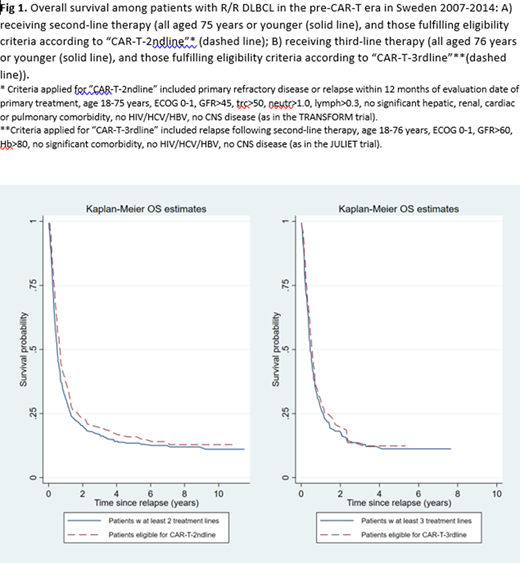Background
Today, even though most patients with diffuse large B-cell lymphoma (DLBCL) can be cured with standard immunochemotherapy, 20-30% are refractory to primary therapy or relapse during follow-up with a drastic worsening of the prognosis. In recent years, new promising treatment options including CAR-T cell therapy are becoming available for relapsed/refractory (R/R) DLBCL patients although so far with logistic challenges including disease control and toxicities, and a considerable cost. In view of these challenges, we aimed to estimate the proportion of patients with R/R DLBCL that are likely to be eligible for CAR-T cell therapy in clinical routine, and their expected outcome in the pre-CAR-T era.
Methods
All patients with DLBCL starting primary therapy with curative intent were identified in the Swedish Lymphoma Register for the period 2007-2014 (N=3550). Primary CNS and primary mediastinal B-cell lymphomas were excluded. Data regarding primary treatment response and relapse was validated through medical chart review in the entire cohort during follow-up until Dec 31st 2017, and information about additional treatment lines including disease characteristics, blood test results, and relapse treatment response was collected. Eligibility for CAR-T cell therapy was estimated retrospectively based on eligibility criteria specified in clinical trials, both at first relapse by applying similar criteria as in the ongoing TRANSFORM, ZUMA-7 or PILOT studies (hereafter termed "CAR-T-2ndline"), and at second relapse applying criteria similar to those specified in the JULIET trial (hereafter termed "CAR-T-3rdline"). Administration of second- and third-line therapies and corresponding response rates were considered as proxies for eligibility and response to bridging therapies. Criteria applied for "CAR-T-2ndline" included R/R DLBCL within 12 months of evaluation date of primary treatment, age 18-75 years, ECOG 0-1, and additional criteria as specified in the TRANSFORM trial (see figure footnote). Criteria applied for "CAR-T-3rdline" included relapse following second-line therapy, age 18-76 years, ECOG 0-1, and additional criteria as in the JULIET trial (see figure footnote). Individuals with missing data on performance status were assumed ineligible. We lacked information about other malignancies in the disease history. Overall survival probabilities were estimated with the Kaplan-Meier method among all R/R DLBCL patients in the trial-specified age intervals and separately among those fulfilling all trial criteria.
Results
In the cohort of 3550 curatively treated DLBCL patients, 847 (cumulative incidence 23%) experienced R/R disease during a median follow-up of 4.3 years. Median age at first relapse was 71 years (range 18-95 years). Overall, 308 patients ≤75 years experienced progression/relapse within 12 months and were able to start second-line therapy. Of these, 148 patients (17% of all R/R DLBCL patients) fulfilled trial eligibility criteria for "CAR-T-2ndline", of whom 60 responded with at least partial remission (overall response rate, ORR, 41%). At second relapse, 370 patients 76 years or younger received third-line therapy, of whom 55 (6.5% of all R/R DLBCL patients) were deemed eligible for "Car-T-3rdline", and 13 responded (ORR 24%, another 5 patients had SD). Two-year overall survival (OS) among all R/R DLBCL patients ≤75 years receiving second-line therapy was 20% (95% confidence interval, CI, 16-25%) (Fig 1). Among those eligible for "CAR-T-2ndline", 2-year OS was 24% (95% CI 17-31%). Among patients ≤76 years at second relapse, 2-year OS was 18% (95% CI 13-24%), and among those eligible for "CAR-T-3rdline", 21% (95% CI 11-32%).
Conclusion
In the population-based setting, one in six patients (17%) with R/R DLBCL fitted trial eligibility criteria for CAR-T-cell therapy at first relapse and only one in fifteen patients (6.5%) fitted trial criteria at second relapse at retrospective evaluation. Figures were reduced when adding requirement of response to relapse/bridging therapy. These estimates illustrate to what extent current CAR-T cell therapies may be applied in a routine setting when based on trial criteria, and the need for development of modified and additional therapies in this group. Outcome estimation confirmed a poor outcome in these groups and did not indicate that fulfillment of trial criteria led to selection bias in terms of survival.
Ekstroem Smedby:Janssen Cilag: Research Funding; Celgene: Other: Advisory Board; Takeda: Research Funding. Harrysson:Janssen Cilag: Research Funding. Jerkeman:Janssen: Research Funding; Roche: Research Funding; Celgene: Research Funding; Abbvie: Research Funding; Gilead: Research Funding. Eloranta:Janssen Cilag: Research Funding.
Author notes
Asterisk with author names denotes non-ASH members.


This feature is available to Subscribers Only
Sign In or Create an Account Close Modal